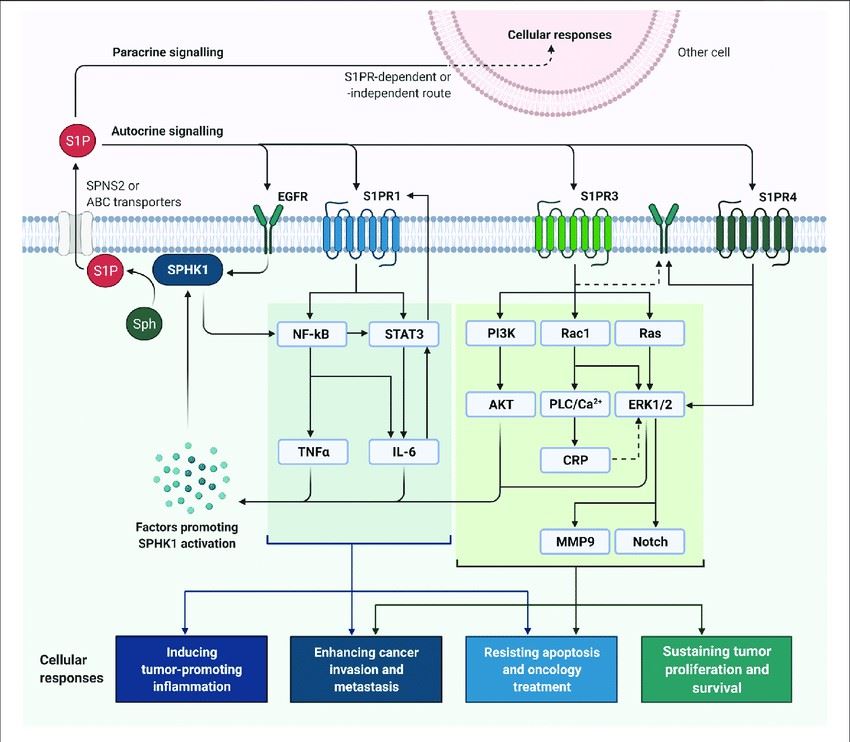What is SPHK1 Protein?
The SPHK1 protein, scientifically known as Sphingosine Kinase 1, is an essential enzyme that plays an integral role in the body's cellular mechanisms. Its functions extend to processes such as cell growth, apoptosis, cellular survival, inflammation, and immune response. In recent years, the medical and scientific community has shown a keen interest in this protein, as its regulation could potentially treat various human diseases.
The Discovery and Background of SPHK1 Protein
The discovery of SPHK1 protein branches from the study of sphingolipids, essential components of all cell membranes. The study of sphingolipids bloomed in the late 1970s when it was first identified as bioactive molecules involved in diverse cellular processes. SPHK1 protein's discovery marked a significant milestone in this field, providing a new dimension to the understanding of cellular metabolism and regulation.
The SPHK1 protein is coded by a gene in humans, named the SPHK1 gene. Its gene locus points to chromosome 17q25.2, meaning it is present on the long arm (q) of chromosome 17 at position 25.2. The information encoded in this gene facilitates a natural process that converts sphingosine to sphingosine-1-phosphate (S1P), a lipid mediator with both intracellular and extracellular functions.
The structure of SPHK1 protein is unique as well. The enzyme consists of five domains, two of which are catalytic domains that bind to sphingosine and ATP. The assembly of these domains allows the protein to perform its function efficiently.
Function of SPHK1 Protein
The primary function of the SPHK1 protein is to facilitate the process that converts sphingosine to S1P, a molecule involved in signal transduction. This biochemical reaction initiates a signaling pathway involved in cellular growth and proliferation. Moreover, SPHK1 stands as a dominant regulator of a balance within the sphingolipid rheostat, controlling the levels of pro-apoptotic sphingosine and sphingosine-1-phosphate, a potent cellular survival facilitator.
SPHK1 Protein Related Signal Pathway
The SPHK1 protein interfaces with numerous signal pathways, thereby influencing an expansive range of physiological processes. For instance, it plays a vital role in activating the ERK-1/2 and PI3K/Akt pathways, crucial for cell survival and proliferation.
In addition, SPHK1's role in the metabolism of sphingosine to S1P initiates the sphingolipid signaling pathway. S1P acts as a signaling molecule that can bind to a family of G protein-coupled receptors, influencing various cellular responses, primarily related to inflammation, immune response, cell growth, and apoptosis.

Fig1. SPHK1/S1P signaling in breast cancer cells
SPHK1 Protein Related Diseases
Given its integrating role across numerous cellular processes, dysfunctional SPHK1 protein is often associated with various diseases. Studies have linked elevated levels of SPHK1 and S1P signaling to cancers, including breast, colorectal, gastric, and lung cancers. It is hypothesized that the overexpression of SPHK1 promotes cell survival and proliferation, advancing the growth and spread of cancerous cells.
Furthermore, SPHK1's role in inflammation and immune response also implicates it in inflammatory and auto-immune diseases, including rheumatoid arthritis, atherosclerosis, and multiple sclerosis.
SPHK1 Protein's Applications in Biomedicine
The biomedical implications of SPHK1 are vast. Its role in numerous diseases, particularly cancer, creates opportunities for therapeutic intervention. Inhibitors targeting SPHK1 show promising outcomes in preventing the growth and spread of cancerous cells.
Moreover, modifying the S1P signaling pathway, directed by the SPHK1 protein, has potential implications in treating inflammatory and autoimmune diseases. With the continued research and better understanding of SPHK1, it opens up promising avenues for many therapeutic applications.
In conclusion, the SPHK1 protein contributes a significant understanding of the cellular mechanics within the human body. From its discovery, we have recognized its decisive role in maintaining cell survival and proliferation and regulating inflammatory and immune responses. Scientists are presently peeling back the layers of its involvement in numerous diseases, which positions the SPHK1 protein as a potent target for therapeutic solutions.
Our Featured Products
| Cat.No. | Product Name | Species | Source (Host) | Tag |
|---|---|---|---|---|
| SPHK1-2915H | Recombinant Human SPHK1, GST-tagged | Human | E.coli | GST |
| SPHK1-1483H | Active Recombinant Human SPHK1 (Active), GST-tagged | Human | Sf9 Insect Cell | GST |
| SPHK1-77H | Recombinant Human SPHK1 protein, Flag-tagged, Biotinylated | Human | Insect Cell | Flag |
| SPHK1-2567H | Recombinant Human SPHK1 Protein, MYC/DDK-tagged | Human | HEK293 | Myc/DDK |
| SPHK1-0269H | Recombinant Human SPHK1 Protein (M1-S363), Tag Free | Human | Insect Cell | No tag |
| SPHK1-6385HF | Active Recombinant Full Length Human SPHK1 Protein, GST-tagged | Human | Insect (sf21) | GST |
| SPHK1-4130H | Recombinant Human SPHK1 Protein, His (Fc)-Avi-tagged | Human | HEK293 | His (Fc)-Avi |
Reference
- Hii, Ling-Wei & Chung, Felicia & Mai, Chun-Wai & Ng, Pei & Leong, Chee-Onn. (2021). Sphingosine Kinase 1 Signaling in Breast Cancer: A Potential Target to Tackle Breast Cancer Stem Cells. Frontiers in Molecular Biosciences. 8. 748470. 10.3389/fmolb.2021.748470.

